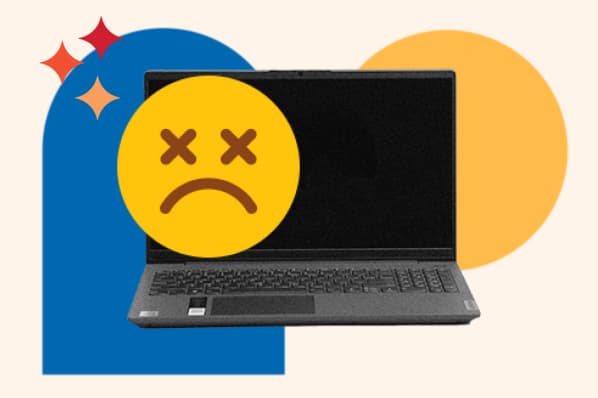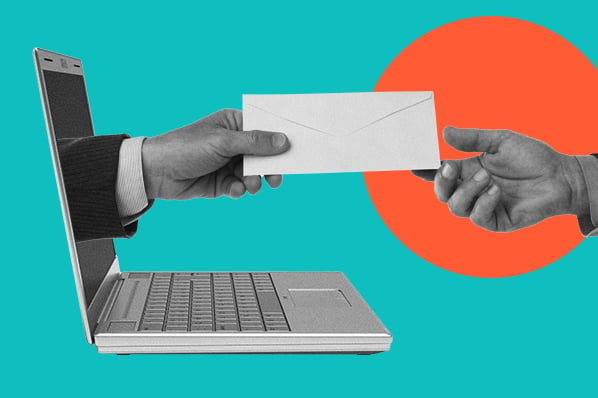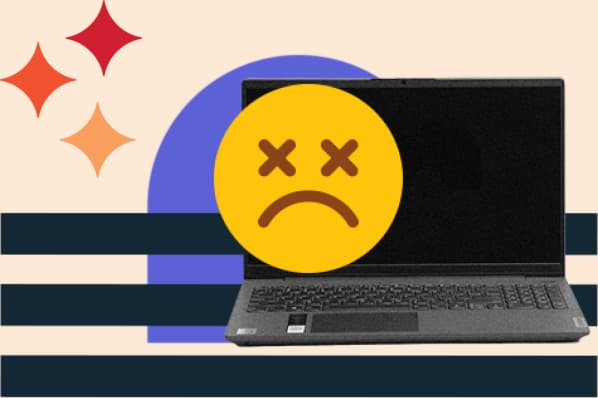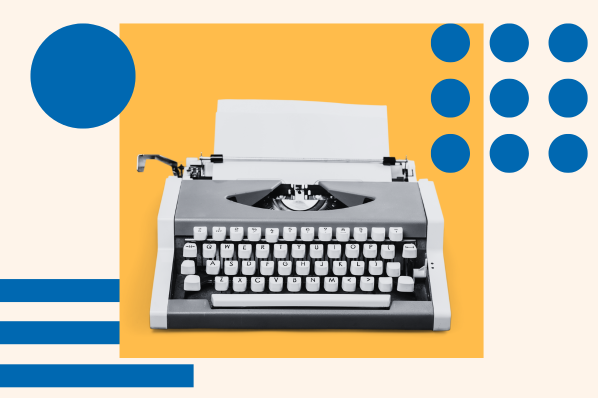Whether you are a new hire or a seasoned manager, your email etiquette determines if you thrive in the workplace.

Email etiquette dictates what’s appropriate when you’re sending a message to a prospective customer, business partner, coworker, manager, or acquaintance. These guidelines help you avoid miscommunications and mistakes which can reflect poorly on you and the organization you represent.
Here are a few email etiquette tips every professional should follow.
What is email etiquette?
Email etiquette includes social guidelines that influence how people interact with each other over email. These recommendations can vary slightly by industry, company, and even generation. However, the spirit of email etiquette remains to communicate clearly and respectfully.
Business communications will often be straightforward and professional. As you develop a relationship with the person you're emailing (prospect or colleague), you can use more casual language while still maintaining a professional tone. This allows your personality to shine through so that others can get to know you better and feel comfortable doing business with you.
You can also learn how to use workplace email most effectively here.
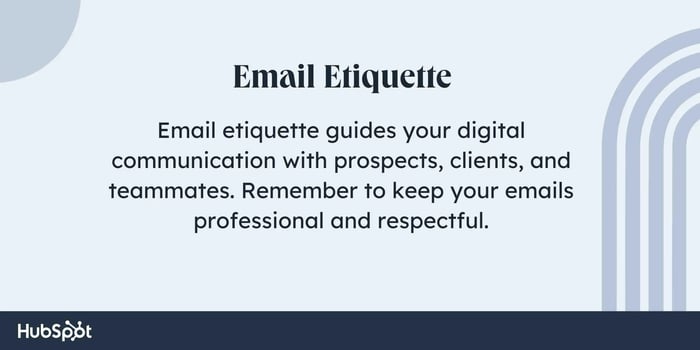
Why is email etiquette important?
Embracing email etiquette will help you establish your professionalism, communicate better, and build strong relationships. This goes a long way in smoothing your career path.
Following these guidelines, you can make sure your goals are clearly communicated over email. You’ll be able to get work done more efficiently and keep a healthy record of emails for your team to refer back to.
Email Etiquette Tips & Examples
- Keep your tone professional.
- Avoid vague subject lines.
- Use proper email punctuation.
- Practice good grammar.
- Resist emojis in email.
- Keep subject lines descriptive and short.
- Choose your email salutation carefully.
- Leave the right impression with your email sign-off.
- Triple-check your recipient's name.
- Use sentence case.
- Consider your email's tone.
- Always use standard fonts and formatting.
- Shorten your URLs
- Call out attachments.
- Perfect your email signature.
- Fill out your email fields properly.
- Use Bcc appropriately.
- Use 'Reply all' sparingly.
- Think before forwarding.
- Respond in a timely manner.
- Set informative out-of-office replies.
- Track email opens and click-through rates.
- Don't add that 'Sent from my phone' caveat.
- Introduce yourself.
- Structure the email properly.
- Be careful with humor.
- Reply to all your emails.
1. Keep your tone professional.
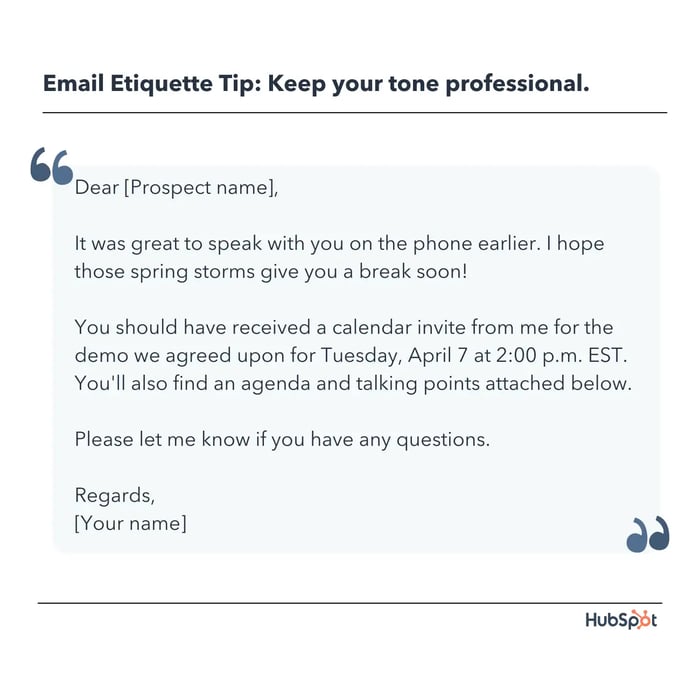
Since you still don't know your prospect well after your discovery call, it's best to keep your subject line descriptive and your greeting formal.
In the example above, you've reminded them of your earlier conversation and kept things friendly. You've also confirmed your scheduled meeting and called out the tidy agenda attachment, so it doesn't get lost below.
Finally, you've signed off formally, which is fitting for this stage of the sales process. This email example shows a high level of email etiquette that just about anyone would appreciate.
2. Avoid vague subject lines
Most people open their emails based on the subject line. Keep your subject lines descriptive, clear, and actionable, especially if the email is for marketing purposes. For example, "how to write a proper email" is a better subject line than "email writing rules."
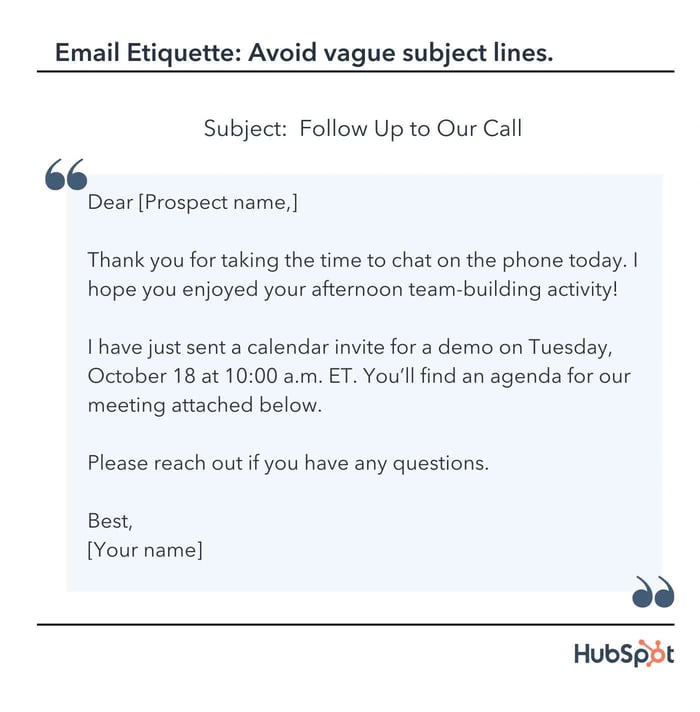
The image above has a subject line that gets straight to the point. "Follow Up to Our Call" is both descriptive and brief.
3. Use proper email punctuation.
Punctuation is subtle when you use it correctly and obvious when you don’t. Don’t make your recipients cringe — memorize these rules and follow them religiously.
Terminal Punctuation
Every line should end with a terminal punctuation mark, i.e. a period, question mark, or exclamation mark. If you skip terminal punctuation, it’ll look like you never completed your thought.
Here’s an example:
- Incorrect: "I talked to Finance, and they approved the agreement"
- Correct: "I talked to Finance, and they approved the agreement."
Use question marks sparingly. If you use too many question marks in one email, you’ll sound like you’re interrogating the recipient.
- Incorrect: "What’s your status? Have you talked to your team yet? Are you free for a call tomorrow at noon so we can discuss any potential changes?"
- Correct: “I’m checking in to understand your team’s status. Are you free for a call tomorrow at noon so we can discuss any potential changes?”
Semicolon (;)
A semicolon can also connect two unique, but related sentences. Commas cannot replace a semicolon.
- Incorrect: "She can call me tomorrow, she can give me an answer then."
- Correct: "She can call me tomorrow; she can give me an answer then."
Comma (,)
One of the most common bloopers is adding commas where they don’t belong. While I could devote an entire post to roper comma usage (English major talking), here are the most important rules:
- Use a comma before a coordinating conjunction (and, but, for, or, nor, so, yet) that connects two independent clauses.
- “I worked with a similar client last year, and their open rates went up 20% in one month.
- Use a comma after a dependent clause at the beginning of a sentence.
- “After improving their subject lines, open rates improved dramatically.
- Use a comma to separate items in a list.
- “I focused on email length, readability, and content.
Salutation Punctuation
There are a few different ways to punctuate your salutation (the first line of your email where you address the recipient by name).
- If it’s a formal email, use a colon.
- Dear Ms. Frost:
- If it’s a relatively casual email, use a comma.
- Dear Aja,
- You can also use an em dash.
- Hi Aja —
Exclamation Mark
Use exclamation marks as sparingly as you use question marks. You'll come across as hyper and overexcited if you go overboard with exclamation marks.
- Incorrect: "Thanks again for a productive conversation yesterday! Good news, I talked to Finance and we’re good to go! Can’t wait to work together!"
- Correct: "Thanks again for a productive conversation yesterday. Good news, I talked to Finance and we’re good to go. Can’t wait to work together!"
In general, exclamation marks aren't considered professional. They work great for happy hour text messages to friends, though.
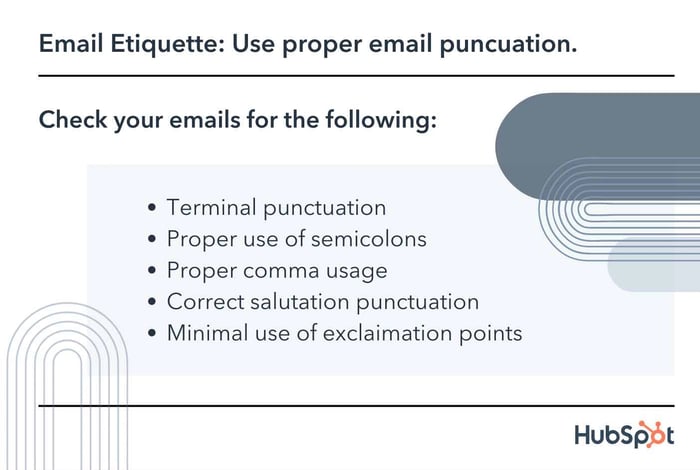
4. Practice good grammar
Unless you devote your full attention to studying grammar, you’re bound to make the occasional mistake. The good news is that as long as you avoid basic mix-ups that your recipient will definitely catch, you will be fine.
Any professional should know the difference between the examples below:
- There/they’re/their
- Its/it’s
- Effect/affect
- Your/you’re
- Too/two/to
- Loose/lose
- I/me/myself
Pro tip: Do you ever wish you could have an editor reading over your shoulder? Consider a digital solution. Grammarly is a free tool that scans everything you write for grammar and spelling mistakes. Not only will it catch issues in real time, but it’ll also send you a weekly report highlighting your most common mistakes.
5. Resist emojis in emails.
I understand the urge to add a smiley face to a potentially harsh sentence or cap off a joke with a laughing emoji. Indeed in some industries, adding emojis to the subject line might increase your open rates. 67% of people agree that using emojis makes you seem friendlier, funnier, or cooler.
However, unless your recipient has already used one, or you are sure that it suits your brand's image, resist temptation.
6. Keep subject lines descriptive and short.
Your subject line should be descriptive and relatively short. Ideally, it should give the recipient a good idea of whether they want to open your message.
- Bad subject line: “Hi"
What are you emailing them about? It’s completely unclear.
- Good subject line: “Summary of December 2 call"
This line leaves no doubt about the contents of the email.
7. Choose your email salutation carefully.
We’ve covered which punctuation to use in the salutation. You also need to pick a greeting — which can be formal or informal, depending on whom you’re emailing and what your relationship is like.
Most of the time, a casual salutation is appropriate. You’ll set a friendly, easygoing tone and communicate confidence.
Casual email greetings include:
- Hi
- Hey
- Hey/hi there
- Good [morning, afternoon]
- [Name]
If you’re reaching out to someone for the first time — or if they work in a conservative industry — err on the side of formality.
Here are some formal email greetings:
- Dear [first name]
- Dear Mr./Ms. [last name]
And greetings you should avoid using in a professional setting:
- Yo: Too informal
- Hey!: Too intimate and eager
- [Name]!: Too off-putting
- To whom it may concern: Too impersonal
- Dear sir or madam: Too stiff
- Hi friend: Too intimate
- Gentlemen: Too old-fashioned
- All: Too cold
8. Leave the right impression with your email sign-off.
The right sign-off will complement the tone and content of your email. Since it’s the last thing your recipient reads, this line influences their lasting impression.
If your tone is lighthearted, end with a warm sign-off.
Informal sign-offs:
- Thanks
- Thanks again
- Best
- Cheers
- Happy [day of the week]
- Enjoy the weekend
- Talk soon
- Talk to you [tomorrow, on Wednesday, when you get back]
- Looking forward to working together
- Looking forward to our next conversation
- Excited to hear your thoughts
If your tone is more reserved, your sign-off should be as well.
Formal sign-offs:
- Thank you
- Thank you for your time
- Have a wonderful [day, weekend]
- Regards
And here are the closing lines you shouldn’t be using:
- Sincerely: Too outdated
- Kind regards: Too unnatural
- Warmly: Too relaxed
- Respectfully: Too random
- Xoxo: Too intimate
- Cordially: Too stilted
- - [Your name]: Too abrupt
9. Triple-check your recipient's name.
Triple-check that you’ve spelled your recipient’s name correctly. It takes two seconds: Just pull up their LinkedIn profile and compare their headline to the name you’ve used. (If you have Sales Hub, this step is even quicker. Their social profiles will show up in your inbox.)
And don’t shorten their name unless they’ve signed their email accordingly. You might assume “Michael" becomes “Mike", but he could prefer going by the latter. Check his signature. If it reads “Mike", you can use the nickname. If it’s “Michael", then that’s what you should address him by.
10. Use sentence case.
When you’re texting or on Slack, you probably don’t capitalize much — if anything. But when you’re writing a professional email, use sentence case. In other words, capitalize the first letter of the first word in a sentence and all proper nouns.
- Example: Dogs are welcome at HubSpot.
11. Consider your email's tone.
It’s incredibly hard to get the right tone across over email. Research shows people dramatically overestimate how often their recipients would correctly identify if their tone was sarcastic or serious.
While they believed recipients would get it right 80% of the time, the reality was closer to 56%.
Does that mean half of your emails will be misinterpreted? No. But it does mean you should think carefully about the words you’re using and how someone else would read them.
First, avoid negative phrases. They can make you seem more anxious, irritated, or worried than you truly are.
- Examples: Mistakes, issues, failure, delay, problem, crisis, trouble, unfortunate, consequence.
Second, don’t be sarcastic. There’s a good chance your recipient won’t get the joke.
- Example: “I’d ask my team to review it tomorrow, but as you probably know, no one actually gets work done on Friday.”
Third, cut out adjectives. They can make you sound overly emotional — you’re shooting for calm and professional.
- Examples: Very, really, extremely, highly, grave, serious, deeply.
Fourth, copy your recipient. Following their lead ensures you won’t accidentally offend them. If they write short, straightforward messages, make yours concise too. If they usually include a rapport-building line (like “I saw you were in Bermuda; hope you had a great time"), do the same.
Fifth, when in doubt, pick up the phone. Whenever you’re having a potentially fraught conversation, it’s always a good idea to call, Zoom, or meet face-to-face with the person.
12. Always use standard fonts and formatting.
Want to make your recipient’s eyes hurt? Use peculiar fonts, wild colors, and offbeat formatting.
Yes, your email might be more memorable, but you’ll look like you’re completely out of touch with communication norms.
Instead, use the standard black font. Use the standard font size. Don’t bold or italicize more than one word (or string of words) in a single email.
And if you’re copying and pasting text, make sure you highlight it and clear the formatting. (Command + \ on a Mac, Ctrl + Shift + N on a PC.) If you don’t, the snippet will appear differently than the rest of your email.
13. Shorten your URLs.
Pasting entire URLs into your email takes up valuable space and looks messy. Instead, create hyperlinks or insert a shortened URL.
- Incorrect: Check this out: https://www.hubspot.com/sales/sales-email
- Correct: Check out this article on sales emails.
14. Call out attachments.
Indicate somewhere in your email you’ve included an attachment so your recipient doesn’t overlook it. A simple “I’ve attached a [document, spreadsheet] for X” will do the trick.
Make sure you’re reattaching files when you add someone to an email chain, or they won’t be able to see them. (An alternative? Simply forward them the thread.)
Another important email etiquette rule regarding attachments is that you shouldn't attach large files like videos to your emails. The best way to send those is to upload the file to a cloud service like Google Drive or Dropbox and provide the recipient with a link that permits them to access it.
15. Perfect your email signature.
A bad email signature can really do a number on your relationships. Even if you write the most eloquent, persuasive message in the world, a poorly designed signature will make you seem like an amateur.
Professional signatures are a chance for you to make it clear who you are, make it easy for people to contact you, and give people a place to go to find out more — either about you or your work.
Keeping in mind: less is more. Your signature should be relatively small, simple, and restrained. Stick to your name, job title, LinkedIn URL and/or company website, and phone number.
Include a signature automatically at the end of each email – it's easier to delete it from a message than to add it manually. You can create a free email signature with Hubspot as well.
You can learn how to easily write a great email signature with this blog post.
16. Fill out your email fields properly.
- To: This field is simple. Add the email address of the person you’re trying to contact.
- Cc: If you’d like to include someone else on the message, Cc them. You’re essentially saying, “Hey, read this, but don’t feel obligated to respond.” Cc’ing someone is necessary when there’s relevant information in the email or you’re connecting them with the actual recipient.
- Bcc: Bcc’ing also copies your contact to the email, but no one besides them will see they received it. In other words, if you send an email to Michael Scott and Bcc Jim Halpert, Michael won’t know Jim got it as well.
17. Use Bcc appropriately.
Bcc can be used to protect someone’s email from being exposed to others. For example, if you’re emailing a group of people about an upcoming event, you may opt to Bcc all emails so you’re not exposing emails without permission.
General FYI: Bcc can let someone see a message without actually including them on all the following threads.
Common Courtesy: Bcc allows you to politely remove people from inbox threads. For example, if your boss is introducing you to someone, Bcc your boss in the response (usually by saying, “Moving [name] to Bcc to save their inbox). This shows you answered without flooding their inbox with the following back and forth.
18. Use 'Reply all' sparingly.
- Reply: When you click "Reply," you respond directly to the person who emailed you last. If you respond directly to the initial message, your reply will go to the original sender of the email. But if you respond to someone else’s email in the thread that follows, you will end up replying just to that person.
- Reply all: When you select "Reply all," you email back everyone who is either in the "To" or “Cc" fields. The benefit of "Reply all" is letting those in the thread know a certain issue has been addressed. It’s also helpful when you have information everyone cares about.
When in doubt, default to "Reply." You don’t want to be the person everyone is secretly rolling their eyes at.
19. Think before forwarding.
There are a few key pointers to keep in mind for proper email forwarding etiquette:
- Some emails are not intended to be forwarded. If a contact is sending you private or sensitive information, use high caution before forwarding it along.
- When forwarding a long email thread, summarize what’s being discussed below so the recipient knows exactly what you want from them. There’s nothing worse than getting forwarded a 50-chain thread with a note that just says, “see below.”
If you’d like your forwarded email to start a new email chain (rather than being a part of your current thread) simply include your own commentary in the subject line.
- Same Thread Subject Line: FW: notes from Tuesday
- New Thread Subject Line: Check this out! FW: notes from Tuesday
20. Respond in a timely manner.
We all have overwhelming inboxes and busy schedules, so it’s not always possible to respond to emails right away. The appropriate response window depends on the person:
- Immediate Teammates: Respond within 12 hours. Your team relies on you to work quickly and efficiently. Plus, most emails are about timely matters.
- General Colleagues: For everyone else you work with, respond within 24 hours. Can’t address their request in that time? Respond by letting them know you’ve read their email and will follow up by X time.
- External Contacts: Unless marked as an urgent email or one that needs an ASAP response, responding to external contacts by the end of the week in which it was sent is perfectly appropriate — so if you received the email Tuesday, respond by Friday of that week. For high-value contacts, it may be worth responding within a 24-hour time frame.
If you work in a customer-facing role, you should know that 88% of customers expect a response to their email in one hour.
Email can be a huge time suck for any professional, but responding to your emails promptly helps keep everyone's work on schedule. One of the best ways to do this is to schedule your emails.
21. Set informative out-of-office replies
If you’re going to be unavailable for an extended period, an automated “OOO” reply — or out-of-office reply — can let whoever is contacting you know that you won’t be able to respond to their message until the date you’ll be in the office again.
Some do's and don'ts for OOO replies:
- DO: Include how long you’ll be unavailable.
- DON’T: Create an OOO response for one day.
- DO: Include another person to contact for more urgent matters.
- DON’T: Include a colleague to contact without letting that colleague know they’re in your OOO reply.
- DO: Include “OOO” in your subject line so people can easily identify the automated response.
- DON’T: Include more detail than needed — such as the exact location of your vacation.
If you're taking a vacation for an extended period, it may be helpful to have a way of earning your attention for truly urgent situations. Here's an email HubSpotter Beth Dunn sent before her month-long sabbatical.

Beth makes it clear she won't be responding to email. Because she's out for an extended period, she shared a clever and easy way to grab her attention when needed.
22. Track email opens and click-through rates.
Rather than sending passive-aggressive “Did you see my email?” messages, use an email tracking tool like HubSpot Sales Hub. You’ll know the exact moment your recipient opened it. If they don’t reply reasonably quickly, you can find a non-irritating reason to follow up, such as, “I read an article on X that reminded me of you; here’s the link if you want to check it out.”
23. Don't add that 'Sent from my phone' caveat.
Should you include “Sent from my iPhone or “Sent via phone — please forgive any typos”? I wouldn’t. Many people take this as an excuse to be lazy and forgo a glance-over before you press “Send.”
24. Introduce yourself.
You should never assume that the recipient knows who you are. Start your email's body with a short introduction containing relevant information about yourself. If you know the recipient but you're not quite sure they remember you, find a way to mention the last time you talked or remind them how you know each other.
25. Structure the email properly.
A professional email should include a subject line, greeting, body, sign-off, and signature. You should always separate these parts with paragraphs to make your message easily readable.
Keep your email body short and concise, and start each paragraph with the most important information. In case you feel the risk of information excess, consider using bullet points or numbered lists to bring more structure to your writing.
26. Be careful with humor.
Without facial expressions or tone of voice, humor used over email can easily get lost in translation. In fact, it is better to keep all forms of humor away from professional email conversations unless you have a personal relationship with the receiver.
Also, something you find funny might not be amusing to someone else. In some cases, humor can seem insensitive or cruel. When in doubt, it’s best to leave it out.
27. Reply to all your emails.
Due to the sheer influx of emails that you get daily, it might be hard to answer every email you receive. Two good ways to combat this are to organize your inbox and try to reply to your emails.
This includes emails that were accidentally sent to you. A reply is not necessary, but it’s always appreciated.
Something short like: “I believe you sent this email to me by mistake. I wanted to let you know so you could get it to the right person.” This would be considered stellar email etiquette.
Email Etiquette and Context
Email is a form of communication, and communication varies from culture to culture. It is always a good idea to customize your message to match the cultural context of your recipient. This way, you can avoid miscommunication and build stronger relationships.
When you can't remember some of the above rules and you get confused because of the many email restrictions, you just have to remember these three Ps: be polite, precise, and professional. They will get you through any email mishap.
Email is one of the most essential tools a salesperson has in their arsenal. Make sure you're using it well with these email etiquette tips, and you'll be on your way to starting genuine relationships with prospects.
Editor's note: This post was originally published in July 2019 and has been updated for comprehensiveness.




![23 Sales Email Templates With 60% or Higher Open Rates [+ Bonus Templates]](https://blog.hubspot.com/hubfs/sales-email-templates-2.jpg)

